Physical and Mechanical Properties of Polypropylene Fibre-Reinforced Cement–Glass Composite
Abstract
Highlights
- Recycled macro-polymer fibres were used to improve tensile strength of the cement–glass composite;
- Reduction of the workability of the cement–glass composite with the addition of polypropylene fibres was obtained;
- Slight effect of waste fibres on the compressive strength of the cement–glass composite was determined;
- With the addition of polypropylene fiber, the flexural strength of the composite increased;
- Significant increase in splitting strength for the fibre-reinforced cement–glass composite was demonstrated.
1. Introduction
2. Materials
2.1. Products of Cementitious Mix
2.2. Polypropylene Fibres
2.3. Mix Composition
2.4. Mix Production
- Glass granulate of 0.9/1.5 mm fraction and a group of granulate fraction 0/0.9 mm—“dry” mixing, mixing time 2 min from the moment of filling the mixing container with the above-mentioned granulate fractions, mixing speed: gear 1, type of agitator: flat;
- Cement binder with filler (glass powder 0/200 µm)—“dry” mixing, mixing time: 2 min from the moment the mixing container is filled with the listed ingredients, mixing speed: gear 1, type of agitator: flat;
- Mixing water with liquid chemical admixture—mixing time: 2 min from the moment of adding both components to the measuring cylinder, mixing speed: gear 1 (mixing takes place with the measuring cylinder by means of a stirrer), type of stirrer: magnetic;
- Glass granulate with cement and glass powder—mixing time: 3 min from the moment of adding all ingredients to the mixing container of the mixer, mixing speed: gear 1, type of agitator: “hook”, dry mixing;
- Glass granulate with cement and glass powder—mixing time: 3 min, mixing speed: gear 2, type of agitator: flat, mixing speed: gear 1, “dry” mixing;
- Glass granulate with cement and glass powder and mixing water with a liquid chemical admixture—mixing time: 3–4 min, mixing speed: gear 1, type of agitator: flat, “wet” mixing;
- Glass gargoyle with cement and glass powder, and mixing water with a liquid chemical admixture—mixing time: 3 min, mixing speed: gear 2, type of agitator: flat, “wet” mixing;
- Glass granulate with cement and glass powder and mixing water with a liquid chemical admixture—mixing time: 3 min, mixing speed: gear 3, type of agitator: flat, “wet” mixing.
3. Methodology
3.1. Test on Mix
3.2. Test on Hardened Concrete
3.2.1. Material Properties
3.2.2. Mechanical Properties
- Static compression test of cubic samples
- Static flexural test of beam samples
- Static splitting test of cubic samples
- Modulus of elasticity and Poisson coefficient
4. Results and Discussion
4.1. Fresh Properties
4.2. Hardened Properties
4.2.1. Density
4.2.2. Compressive Strength
4.2.3. Flexural Strength
4.2.4. Splitting Strength
4.2.5. Modulus of Elasticity and Poisson Ratio
5. Conclusions
- An effect of a decrease in the slump cone with the addition of PP fibres was noted; the reference mix and the mix with a lower fibre content were within slump class S2, but the mix with higher PP fibre content was within slump class S1.
- The amount of air in the cement–glass composite mix was equal to 4.0 ± 0.5%. The addition of fibres did not affect the air content of the mixture.
- With the increase of PP fibre content, the density of the cement–glass composite increased, but this effect was negligible (2–3% compared with the reference sample).
- With the addition of 0.0625%, 0.1250%, 0.1875%, 0.2500%, and 0.3125 wt.% polypropylene fibre, the increase in flexural strength of the cement–glass composite compared with the reference sample was about 4%, 8%, 14%, 20%, and 27%, respectively, while the increase in splitting strength was about 48%, 60%, 132%, 156%, and 220%, respectively. The effect of the increase in splitting strength was much larger than the increase in flexural strength. The compressive strength increased slightly with the increasing PP fibre content, which was unexpected owing to the principle that fibres improve tensile strength, but not compressive strength (0.1%, 0.6%, 1.6%, 2.3%, and 2.8% increase for 0.025, 0.050, 0.075, 0.100, and 0.125 wt.% polypropylene fibre, respectively).
- The elastic modulus of the cement–glass composite with content of 0.0625%, 0.1250%, 0.1875%, 0.2500%, and 0.3125 wt.% PP fibre was about 31 ± 1 GPa regardless of fibre content, and was equal to plain concrete with granite aggregate.
- The addition of PP fibre up to 0.3125% of the cement did not affect the Poisson ratio.
Author Contributions
Funding
Institutional Review Board Statement
Informed Consent Statement
Data Availability Statement
Acknowledgments
Conflicts of Interest
References
- Kijeński, J.; Błędzki, A.; Jeziórska, R. Recovery and Recycling of Polymeric Materials [Odzysk i Recykling Materiałów Polimerowych]; PWN: Warsaw, Poland, 2011. [Google Scholar]
- Plastics Europe. The Compelling Facts about Plastics–Analysis of Plastics Production, Demand and Recovery for 2008 in Europe; Plastics Europe: Brussels, Belgium, 2008. [Google Scholar]
- Knap, P. The Influence of Raw Materials on the Load-Bearing Capacity of Plastic Connectors in Building Fastenings [Wpływ Surowców na Nośność Łączników Tworzywowych w Zamocowaniach Budowlanych]. Ph.D. Thesis, Building Research Institute, Varsav, Poland, 20 April 2017. [Google Scholar]
- Plastics Europe Polska. Analysis of Production, Demand and Recovery of Plastics in Europe in 2011 [Analiza Produkcji, Zapotrzebowanie oraz Odzysk Tworzyw Sztucznych w Europie w Roku 2011]; Plastics Europe Polska: Warszawa, Poland, 2012. [Google Scholar]
- Pilz, H.; Brandt, B.; Fehringer, R. Wpływ Tworzyw Sztucznych na Zużycie Energii Oraz na Emisję Gazów Cieplarnianych w Europie z Uwzględnieniem Całego Cyklu Życia Wyrobów; Denkstatt GmbH: Vienna, Austria, 2010. [Google Scholar]
- Baker Institute. Pandemic, Plastics and the Continuing Quest for Sustainability. Forbes Media LLC 2020. Available online: https://www.forbes.com/sites/thebakersinstitute/2020/04/14/pandemic-plastics-and-the-continuing-quest-for-sustainability/#36f2b4a477b4 (accessed on 27 November 2020).
- Tan, K.H.; Du, H. Use of waste glass as sand in mortar: Part I—Fresh, mechanical and durability properties. Cem. Concr. Compos. 2013, 35, 109–117. [Google Scholar] [CrossRef]
- EPA. United States Environmental Protection Agency, Advancing Sustainable Materials Management: 2017 Fact Sheet, EPA. United States Environmental Protection Agency. 2017. Available online: https://www.epa.gov/sites/production/files/2019-11/documents/2017_facts_and_figures_fact_sheet_final.pdf (accessed on 27 November 2020).
- LCQ9. Recovery and Recycling of Waste Glass. 2020. Available online: https://www.info.gov.hk/gia/general/202001/08/P2020010800455p.htm (accessed on 27 November 2020).
- Bostanci, S.C.; Limbachiya, M.; Kew, H. Portland-composite and composite cement concretes made with coarse recycled and recycled glass sand aggregates: Engineering and durability properties. Constr. Build. Mater. 2016, 128, 324–340. [Google Scholar] [CrossRef]
- Liu, F.; Ding, W.; Qiao, Y. An experimental investigation on the integral waterproofing capacity of polypropylene fiber concrete with fly ash and slag powder. Constr. Build. Mater. 2019, 212, 675–686. [Google Scholar] [CrossRef]
- Sabet, F.A.; Libre, N.A.; Shekarchi, M. Mechanical and durability properties of self consolidating high performance concrete incorporating natural zeolite, silica fume and fly ash. Constr. Build. Mater. 2013, 44, 175–184. [Google Scholar] [CrossRef]
- Rudnicki, T.; Wołoszka, P. The use of technology whitetopping in the aspect of implementation of repairs of flexible pavements. Bull. Mil. Univ. Technol. 2016, 65, 3. [Google Scholar]
- Limbachiya, M.; Meddah, M.S.; Ouchagour, Y. Use of recycled concrete aggregate in fly-ash concrete. Constr. Build. Mater. 2012, 27, 439–449. [Google Scholar] [CrossRef]
- Gesoğlu, M.; Güneyisi, E.; Özbay, E. Properties of self-compacting concretes made with binary, ternary, and quaternary cementitious blends of fly ash, blast furnace slag, and silica fume. Constr. Build. Mater. 2009, 23, 1847–1854. [Google Scholar] [CrossRef]
- Kadela, M.; Kukiełka, A. Influence of foaming agent content in fresh concrete on elasticity modulus of hard foam concrete. In Brittle Matrix Composites 11, Proceedings of the 11th International Symposium on Brittle Matrix Composites BMC 2015, Warsaw, Poland, 28–30 September 2015; Institute of Fundamental Technological Research PAS: Warsaw, Poland, 2015; pp. 489–496. [Google Scholar]
- Rudnicki, T.; Jurczak, R. Recycling of a Concrete Pavement after over 80 Years in Service. Materials 2020, 13, 2262. [Google Scholar] [CrossRef]
- Osborne, G.J. Durability of Portland blast-furnace slag cement concrete. Cem. Concr. Compos. 1999, 21, 11–21. [Google Scholar] [CrossRef]
- De Domenico, D.; Faleschini, F.; Pellegrino, C.; Ricciardi, G. Structural behavior of RC beams containing EAF slag as recycled aggregate: Numerical versus experimental results. Constr. Build. Mater. 2018, 171, 321–337. [Google Scholar] [CrossRef]
- Menéndez, G.; Bonavetti, V.; Irassar, E.F. Strength development of ternary blended cement with limestone filler and blast-furnace slag. Cem. Concr. Compos. 2003, 25, 61–67. [Google Scholar] [CrossRef]
- Hama, S.M.; Hilal, N.N. Fresh properties of self-compacting concrete with plastic waste as partial replacement of sand. Int. J. Sustain. Built Environ. 2017, 6, 299–308. [Google Scholar] [CrossRef]
- Choi, Y.W.; Moon, D.J.; Chumg, J.S.; Cho, S.K. Effects of waste PET bottles aggregate on the properties of concrete. Cem. Concr. Compos. 2005, 35, 776–781. [Google Scholar] [CrossRef]
- Saxena, R.; Siddique, S.; Gupta, T.; Sharma, R.K.; Chaudhary, S. Impact resistance and energy absorption capacity of concrete containing plastic waste. Constr. Build. Mater. 2018, 176, 415–421. [Google Scholar] [CrossRef]
- Mohammadinia, A.; Wong, Y.C.; Arulrajah, A.; Horpibulsuk, S. Strength evaluation of utilizing recycled plastic waste and recycled crushed glass in concrete footpaths. Constr. Build. Mater. 2019, 197, 489–496. [Google Scholar] [CrossRef]
- Choi, Y.W.; Moon, D.J.; Kim, Y.J.; Lachemi, M. Characteristics of mortar and concrete containing fine aggregate manufactured from recycled waste polyethylene terephthalate bottles. Constr. Build. Mater. 2009, 23, 2829–2835. [Google Scholar] [CrossRef]
- Gesoğlu, M.; Güneyisi, E.; Hansu, O.; Etli, S.; Alhassan, M. Mechanical and fracture characteristics of self-compacting concretes containing different percentage of plastic waste powder. Constr. Build. Mater. 2017, 140, 562–569. [Google Scholar] [CrossRef]
- Asokan, P.; Osmani, M.; Price, A.D.F. Improvement of the mechanical properties of glass fibre reinforced plastic waste powder filled concrete. Constr. Build. Mater. 2010, 24, 448–460. [Google Scholar] [CrossRef]
- Jackowski, M.; Małek, M.; Życiński, W.; Łasica, W.; Owczarek, M. Characterization of new recycled polymers shots addition for the mechanical strength of concrete. Mater. Tehnol. 2020, 54, 355–358. [Google Scholar] [CrossRef]
- Mahdi, F.; Khan, A.A.; Abbas, H. Physiochemical properties of polymer mortar composites using resins derived from post-consumer PET bottles. Cem. Concr. Compos. 2007, 29, 241–248. [Google Scholar] [CrossRef]
- Pacheco-Torgal, F.; Ding, Y.; Jalali, S. Properties and durability of concrete containing polymeric wastes (tyre rubber and polyethylene terephthalate bottles): An overview. Constr. Build. Mater. 2012, 30, 714–724. [Google Scholar] [CrossRef]
- Yin, S.; Tuladhar, R.; Shi, F.; Combe, M.; Collister, T.; Sivakugan, N. Use of macro plastic fibers in concrete: A review. Constr. Build. Mater. 2015, 93, 180–188. [Google Scholar] [CrossRef]
- Kou, S.C.; Lee, G.; Poon, C.S.; Lai, W.L. Properties of lightweight aggregate concrete prepared with PVC granules derived from scraped PVC pipes. Waste Manag. 2009, 29, 621–628. [Google Scholar] [CrossRef] [PubMed]
- Pesic, N.; Zivanovic, S.; Gasrcia, R.; Papastergiou, P. Mechanical properties of concrete reinforced with recycled HDPE plastic fibres. Constr. Build. Mater. 2016, 115, 362–370. [Google Scholar] [CrossRef]
- Panyakapo, P.; Panyakapo, M. Reuse of thermosetting plastic waste for lightweight concrete. Waste Manag. 2008, 28, 1581–1588. [Google Scholar] [CrossRef]
- Kan, A.; Demirboga, R. A new technique of processing for waste-expanded polystyrene foams as aggregates. J. Mater. Proc. Technol. 2009, 209, 2994–3000. [Google Scholar] [CrossRef]
- Kim, S.B.; Yi, N.H.; Kim, H.Y.; Kim, J.H.J.; Song, Y.C. Material and structural performance evaluation of recycled PET fiber reinforced concrete. Cem. Concr. Res. 2010, 32, 232–240. [Google Scholar] [CrossRef]
- Szcześniak, A.; Stolarski, A. Dynamic Relaxation Method for Load Capacity Analysis of Reinforced Concrete Elements. Appl. Sci. 2018, 8, 396. [Google Scholar] [CrossRef]
- Kozłowski, M.; Kadela, M. Mechanical Characterization of Lightweight Foamed Concrete. Adv. Mater. Sci. Eng. 2018, 2018, 1–8. [Google Scholar] [CrossRef]
- Kan, A.; Demirboga, R. A novel material for lightweight concrete production. Cem. Concr. Compos. 2009, 31, 489–495. [Google Scholar] [CrossRef]
- Kadela, M.; Kukiełka, A.; Małek, M. Characteristics of Lightweight Concrete Based on a Synthetic Polymer Foaming Agent. Materials 2020, 13, 4979. [Google Scholar] [CrossRef] [PubMed]
- Garbacz, A.; Szmigiera, E.D.; Protchenko, K.; Urbański, M. On Mechanical Characteristics of HFRP Bars with Various Types of Hybridization. In International Congress on Polymers in Concrete (ICPIC 2018): Polymers for Resilient and Sustainable Concrete Infrastructure; Taha, M.M.R., Girum, U., Moneeb, G., Eds.; Springer: Berlin/Heidelberg, Germany, 2018; pp. 653–658. [Google Scholar]
- Dudek, D.; Kadela, M. Pull-Out Strength of Resin Anchors in Non-cracked and Cracked Concrete and Masonry Substrates. Procedia Eng. 2016, 161, 864–867. [Google Scholar] [CrossRef]
- Knap, P.; Dudek, D. Impact of the Degree of Concrete Cracking on the Pull-out Resistance of Steel and Plastic/Metal Sleeve Anchors. IOP Conf. Series: Mater. Sci. Eng. 2017, 245, 022091. [Google Scholar] [CrossRef]
- Małek, M.; Jackowski, M.; Łasica, W.; Kadela, M. Characteristics of Recycled Polypropylene Fibers as an Addition to Concrete Fabrication Based on Portland Cement. Materials 2020, 13, 1827. [Google Scholar] [CrossRef] [PubMed]
- Meyer, C. The greening of the concrete industry. Cem. Concr. Compos. 2009, 31, 601–605. [Google Scholar] [CrossRef]
- Nassar, R.-U.-D.; Soroushian, P. Green and durable mortar produced with milled waste glass. Mag. Concr. Res. 2012, 64, 605–615. [Google Scholar] [CrossRef]
- Nassar, R.-U.-D.; Soroushian, P. Strength and durability of recycled aggregate concrete containing milled glass as partial replacement for cement. Constr. Build. Mater. 2012, 29, 368–377. [Google Scholar] [CrossRef]
- Ghaffary, A.; Moustafa, M.A. Synthesis of Repair Materials and Methods for Reinforced Concrete and Prestressed Bridge Girders. Materials 2020, 13, 4079. [Google Scholar] [CrossRef]
- Ramdani, S.; Guettala, A.; Benmalek, M.L.; Aguiar, J.B. Physical and mechanical performance of concrete made with waste rubber aggregate, glass powder and silica sand powder. J. Build. Eng. 2019, 21, 302–311. [Google Scholar] [CrossRef]
- Ankur, M.; Randheer, S. Comparative Study of Waste Glass Powder as Pozzolanic Material in concrete. Bachelor’s Thesis, Department of Civil Engineering, National Institute of Technology, Deemed University, Rourkela, India, 18, May, 2012. [Google Scholar]
- Kou, S.C.; Xing, F. The effect of recycled glass powder and reject fly ash on the mechanical properties of fiber-reinforced ultralight performance concrete. Adv. Mater. Sci. Eng. 2012, 2012, 263243. [Google Scholar] [CrossRef]
- Hendi, A.; Mostofinejad, D.; Sedaghatdoost, A.; Zohrabi, M.; Naeiimi, N.; Tavakolinia, A. Mix design of the green self-consolidating concrete: Incorporating the waste glass powder. Constr. Build. Mater. 2019, 199, 369–384. [Google Scholar] [CrossRef]
- Soliman, N.A.; Tagnit-Hamou, A. Development of ultra-high-performance concrete using glass powder—Towards ecofriendly concrete. Constr. Build. Mater. 2016, 125, 600–612. [Google Scholar] [CrossRef]
- Kadela, M.; Kozłowski, M.; Kukiełka, A. Application of foamed concrete in road pavement–weak soil system. Procedia Eng. 2017, 193, 439–446. [Google Scholar] [CrossRef]
- Spiesz, P.; Rouvas, S.; Brouwers, H.J.H. Utilization of waste glass in translucent and photocatalytic concrete. Const. Build. Mat. 2016, 128, 436–448. [Google Scholar] [CrossRef]
- Najad, A.A.A.; Kareem, H.J.K.; Azline, N.; Ostovar, N. Waste glass as partial replacement in cement—A review. IOP Conf. Ser.: Earth Environ. Sci. 2019, 357, 012023. [Google Scholar] [CrossRef]
- Federico, L.M.; Chidiac, S.E. Waste glass as a supplementary cementitious material in concrete—Critical review of treatment methods. Cem. Concr. Compos. 2009, 31, 606–610. [Google Scholar] [CrossRef]
- Mirzahosseini, M.; Riding, K.A. Effect of curing temperature and glass type on the pozzolanic reactivity of glass powder. Cem. Concr. Res. 2014, 58, 103–111. [Google Scholar] [CrossRef]
- Johnson, C.D. Waste glass as coarse aggregate for concrete. J. Test. Eval. 1974, 2, 344–350. [Google Scholar]
- Topçu, İ.B.; Canbaz, M. Properties of concrete containing waste glass. Cem. Concr. Res. 2004, 34, 267–274. [Google Scholar] [CrossRef]
- Ling, T.-C.; Poon, C.-S. Utilization of recycled glass derived from cathode ray tube glass as fine aggregate in cement mortar. J. Hazard Mater. 2011, 192, 451–456. [Google Scholar] [CrossRef]
- Yu, X.; Tao, Z.; Song, T.Y.; Pan, Z. Performance of concrete made with steel slag and waste glass. Constr. Build. Mater. 2016, 114, 737–746. [Google Scholar] [CrossRef]
- Limbachiya, M.; Meddah, M.S.; Fotiadou, S. Performance of granulated foam glass concrete. Constr. Build. Mater. 2012, 28, 759–768. [Google Scholar] [CrossRef]
- Tittarelli, F.; Giosuè, C.; Mobili, A. Recycled Glass as Aggregate for Architectural Mortars. Int. J. Concr. Struct. Mater. 2018, 12, 1–11. [Google Scholar] [CrossRef]
- Kou, S.C.; Poon, C.S. Properties of self-compacting concrete prepared with recycled glass aggregate. Cem. Concr. Compos. 2009, 31, 107–113. [Google Scholar] [CrossRef]
- Ling, T.-C.; Poon, C.-S. Properties of architectural mortar prepared with recycled glass with different particle sizes. Mater. Des. 2011, 32, 2675–2684. [Google Scholar] [CrossRef]
- Yousefi, A.; Tang, W.; Khavarian, M.; Fang, C.; Wang, S. Thermal and Mechanical Properties of Cement Mortar Composite Containing Recycled Expanded Glass Aggregate and Nano Titanium Dioxide. Appl. Sci. 2020, 10, 2246. [Google Scholar] [CrossRef]
- EEA. EEA–NEC Report, NEC Directive Status Report 2008; European Environment Agency: København, Denmark, 2008.
- EPA (Environmental Protection Agency). Available and Emerging Technologies for Reducing Greenhouse Gas Emissions from the Portland Cement Industry; EPA: Washington, DC, USA, 2010.
- USGS (US Geological Survey). Background Facts and Issues Concerning Cement and Cement Data; USGS: Reston, VA, USA, 2005.
- Małek, M.; Jackowski, M.; Życiński, W.; Wachowski, M. Characterization of new fillers addition on mechanical strength of concrete. Mater. Tehnol. 2019, 53, 239–243. [Google Scholar] [CrossRef]
- Rudnicki, T. The method of aggregate skeleton in self compacting concrete designing with segment regression. CWB-1 2016, 1, 10–19. [Google Scholar]
- Szcześniak, A.; Zychowicz, J.; Stolarski, A. Influence of Fly Ash Additive on the Properties of Concrete with Slag Cement. Materials 2020, 13, 3265. [Google Scholar] [CrossRef]
- Łasica, W.; Małek, M.; Szcześniak, Z.; Owczarek, M. Characterization of recycled glass-cement composite: Mechanical strength. Mater. Technol. 2020, 54, 473–477. [Google Scholar] [CrossRef]
- Małek, M.; Łasica, W.; Jackowski, M.; Kadela, M. Effect of waste glass addition as replacement of fine aggregate on properties of concrete. Materials 2020, 13, 3189. [Google Scholar] [CrossRef] [PubMed]
- PN EN 196-6:2011. Methods of Testing Cement—Part 6: Determination of Fineness; European Committee for Standardization: Brussels, Belgium, 2019. [Google Scholar]
- PN EN 196-1:2016-07. Methods of Testing Cement—Part 1: Determination of Strength; European Committee for Standardization: Brussels, Belgium, 2016. [Google Scholar]
- Górażdże Group: Cement, Concrete, Aggregate. Technical Data Sheet CEM I 42.5 R. Available online: http://www.gorazdze.pl (accessed on 27 November 2020).
- E-grit Polska. Innovative Product for Cleaning the Surface PANGLASS, Safety Data Sheet Panglass-Glass Flour, Glass Granules. Available online: https://egrit.pl/ (accessed on 27 November 2020).
- PN EN 12350-2:2019-07. Testing Fresh Concrete—Part 2: Slump Test; European Committee for Standardization: Brussels, Belgium, 2019. [Google Scholar]
- ASTM C231/C231M-17a. Standard Test Method for Air Content of Freshly Mixed Concrete by the Pressure Method; ASTM International: West Conshohocken, PA, USA, 2017; Available online: www.astm.org (accessed on 15 April 2017).
- EN 12350-7:2019-08. Testing Fresh Concrete—Part 7: Air Content-Pressure Method; European Committee for Standardization: Brussels, Belgium, 2019. [Google Scholar]
- EN 12390-3:2019-07. Testing Hardened Concrete—Part 3: Compressive Strength of Test Specimens; European Committee for Standardization: Brussels, Belgium, 2019. [Google Scholar]
- EN 12390-5:2019-08. Testing Hardened Concrete—Part 5: Flexural Strength of Test Specimens; European Committee for Standardization: Brussels, Belgium, 2019. [Google Scholar]
- EN 12390-6:2011. Testing Hardened Concrete—Part 6: Tensile Splitting Strength of Test Specimens; European Committee for Standardization: Brussels, Belgium, 2011. [Google Scholar]
- ASTM C215-19. Standard Test Method for Fundamental Transverse, Longitudinal, and Torsional Resonant Frequencies of Concrete Specimens; ASTM International: West Conshohocken, PA, USA, 2019; Available online: www.astm.org (accessed on 1 December 2019).
- Moosberg-Bustnes, H.; Lagerblad, B.; Forssberg, E. The function of fillers in concrete. Mater. Struct. 2004, 37, 74. [Google Scholar] [CrossRef]
- Castro, S.; Brito, J. Evaluation of the durability of concrete made with crushed glass aggregates. J. Clean. Prod. 2013, 41, 7–14. [Google Scholar] [CrossRef]
- Limbachiya, M.C. Bulk engineering and durability properties of washed glass sand concrete. Constr. Build. Mater. 2009, 23, 1078–1083. [Google Scholar] [CrossRef]
- Taha, B.; Nounu, G. Utilizing waste recycled glass as sand/cement replacement in concrete. J. Mater. Civ. Eng. 2009, 21, 709–721. [Google Scholar] [CrossRef]
- Mohammadhosseini, H.; Tahir, M.M. Durability performance of concrete incorporating waste metalized plastic fibres and palm oil fuel ash. Constr. Build. Mater. 2008, 180, 92–102. [Google Scholar] [CrossRef]
- Bayasi, Z.; Zeng, J. Properties of polypropylene fiber reinforced concrete. ACI Mater. J. 1993, 90, 605–610. [Google Scholar]
- Du, H.; Tan, K.H. Use of waste glass as sand in mortar: Part II—Alkali-silica reaction and migration methods. Cem. Con. Compos. 2013, 35, 118–126. [Google Scholar] [CrossRef]
- Lee, G.; Poon, C.S.; Wong, Y.L.; Ling, T.C. Effects of recycled fine glass aggregates on the properties of dry–mixed concrete blocks. Constr. Build. Mater. 2013, 38, 638–643. [Google Scholar] [CrossRef]
- Park, S.B.; Lee, B.C.; Kim, J.H. Studies on mechanical properties of concrete containing waste glass aggregate. Cem. Concr. Res. 2004, 34, 2181–2189. [Google Scholar] [CrossRef]
- Alhozaimy, A.M.; Soroushian, P.; Mirza, F. Mechanical properties of polypropylene fiber reinforced concrete and the effects of pozzolanic materials. Cem. Concr. Compos. 1996, 18, 85–92. [Google Scholar] [CrossRef]
- Aulia, T.B. Effects of polypropylene fibres on the properties of high-strength concretes. LACER 2002, 7, 43–59. [Google Scholar]
- Richardson, A. Compressive strength of concrete with polypropylene fibre additions. Struc. Surv. 2006, 24, 138–153. [Google Scholar] [CrossRef]
- Oni, B.; Xia, J.; Liu, M. Mechanical properties of pressure moulded fibre reinforced pervious concrete pavement brick. Case. Stud. Constr. Mater. 2020, 13, e00431. [Google Scholar] [CrossRef]
- Jiang, C.; Fan, K.; Wu, F.; Chen, D. Experimental study on the mechanical properties and microstructure of chopped basalt fibre reinforced concrete. Mater. Des. 2014, 58, 187–193. [Google Scholar] [CrossRef]
- Grujoska, V.; Grujoska, J.; Samardzioska, T.; Jovanoska, M. Waste glass effects on fresh and hardened concrete. In Proceedings of the 7th International Conference “Civil Engineering—Science and Practice”, Kolasin, Montenegro, 10–14 March 2020. [Google Scholar]
- Jurczak, R.; Szmatuła, F.; Rudnicki, T.; Korentz, J. Effect of Ground Waste Glass Addition on the Strength and Durability of Low Strength Concrete Mixes. Materials 2021, 14, 190. [Google Scholar] [CrossRef]
- Chung, S.-Y.; Elrahman, M.A.; Sikora, P.; Rucinska, T.; Horszczaruk, E.; Stephan, D. Evaluation of the Effects of Crushed and Expanded Waste Glass Aggregates on the Material Properties of Lightweight Concrete Using Image-Based Approaches. Materials 2017, 10, 1354. [Google Scholar] [CrossRef]
- Bajad, M.N.; Modhera, C.D.; Desai, A.K. Effect of glass on strength of concrete subjected to sulphate attack. Int. J. Civil Eng. Res. Dev. 2011, 1, 1–13. Available online: https://papers.ssrn.com/sol3/papers.cfm?abstract_id=3501397 (accessed on 12 November 2020).
- Nassar, R.; Soroushian, P. Field investigation of concrete incorporating milled waste glass. J. Solid Waste Technol. Manag. 2011, 37, 307–319. [Google Scholar] [CrossRef]
- Shao, Y.; Lefort, T.; Moras, S.; Rodriguez, D. Studies on concrete containing ground waste glass. Cem. Concr. Res. 2000, 30, 91–100. [Google Scholar] [CrossRef]
- Shayan, A.; Xu, A. Value-added utilisation of waste glass in concrete. Cem. Concr. Res. 2004, 34, 81–89. [Google Scholar] [CrossRef]
- Shi, C.; Wu, Y.; Riefler, C.; Wang, H. Characteristics and pozzolanic reactivity of glass powders. Cem. Concr. Res. 2005, 35, 987–993. [Google Scholar] [CrossRef]
- Kamali, M.; Ghahremaninezhad, A. Effect of glass powders on the mechanical and durability properties of cementitious materials. Constr. Build. Mater. 2015, 98, 407–416. [Google Scholar] [CrossRef]
- Yamada, K.; Ishiyama, S. Maximum dosage of glass cullet as fine aggregate in mortar. In Proceedings of the International Conference on Achieving Sustainability in Construction, Dundee, UK, 5–6 July 2005; Dhir, R.K., Dyer, T.D., Newlands, M.D., Eds.; Thomas Telford: London, UK, 2005; pp. 185–192. [Google Scholar]
- Jin, W.; Meyer, C.; Baxter, S. Glasscrete-concrete with glass aggregate. ACI Mater. J. 2000, 97, 208–213. [Google Scholar]
- Idir, R.; Cyr, M.; Tagnit-Hamou, A. Use of fine glass as ASR inhibitor in glass aggregate mortars. Constr. Build. Mater. 2010, 24, 1309–1312. [Google Scholar] [CrossRef]
- Xie, Z.; Xiang, W.; Xi, Y. ASR Potentials of Glass Aggregates in Water-Glass Activated Fly Ash and Portland Cement Mortars. J. Mater. Civ. Eng. 2003, 15. [Google Scholar] [CrossRef]
- Singh, V.K. Effect of polypropylene fiber on properties of concrete. Int. J. Eng. Sci. Res. Technol. 2014, 3, 312–317. [Google Scholar]
- Najimi, M.; Farahani, F.M.; Pourkhorshidi, A.R. Effects of polypropylene fibers on physical and mechanical properties of concretes. In Proceedings of the 3rd International Conference on Concrete & Development, CD03-009, Tehran, Iran, 27–29 April 2009; pp. 1073–1081. Available online: https://www.irbnet.de/daten/iconda/CIB13842.pdf (accessed on 20 February 2020).
- Nili, M.; Afroughdaset, V. The effects The effects of silica fume and polypropylene fibers on the impact resistance and mechanical properties of concrete. Constr. Build. Mater. 2010, 24, 927–933. [Google Scholar] [CrossRef]
- Satisha, N.S.; Shruthi, C.G.; Kiran, B.M.; Sanjith, J. Study on effect of polypropylene fibres on mechanical properties of normal strength concrete withpartial replacement of cement by GGBS. Int. J. Adv. Res. Trends Eng. Technol. 2018, 5, 23–51. Available online: www.ijartet.com (accessed on 10 January 2021).
- Badogiannis, E.G.; Christidis, K.I.; Tzanetatos, G.E. Evaluation of the mechanical behavior of pumice lightweight concrete reinforced with steel and polypropylene fibers. Constr. Build. Mater. 2019, 196, 443–456. [Google Scholar] [CrossRef]
- Szeląg, M. Evaluation of cracking patterns of cement paste containing polypropylene fibers. Compos. Struct. 2019, 220, 402–411. [Google Scholar] [CrossRef]
- Afroughsabet, V.; Ozbakkaloglu, T. Mechanical and durability properties of high-strength concrete containing steel and polypropylene fibers. Constr. Build. Mater. 2015, 94, 73–82. [Google Scholar] [CrossRef]
- Castoldi, R.S.; Souza, L.M.S.; Andrade Silva, F. Comparative study on the mechanical behavior and durability of polypropylene and sisal fiber reinforced concretes. Constr. Build. Mater. 2019, 211, 617–628. [Google Scholar] [CrossRef]
- Alrshoudi, F.; Mohammadhosseini, H.; Md. Tahir, M.; Alyousef, R.; Alghamdi, H.; Alharbi, Y.R.; Alsaif, A. Sustainable Use of Waste Polypropylene Fibers and Palm Oil Fuel Ash in the Production of Novel Prepacked Aggregate Fiber-Reinforced Concrete. Sustainability 2020, 12, 4871. [Google Scholar] [CrossRef]
- Rostami, R.; Zarrebini, M.; Mandegari, M.; Sanginabadi, K.; Mostofinejad, D.; Abtahi, S.M. The effect of concrete alkalinity on behavior of reinforcing polyester and polypropylene fibers with similar properties. Cem. Concr. Compos. 2019, 97, 118–124. [Google Scholar] [CrossRef]
- Wadekar, A.P.; Pandit, R.D. Study of different types fibres used in high strength fibre reinforced concrete. Int. J. Innov. Res. Adv. Eng. 2014, 1, 225–230. Available online: www.ijirae.com (accessed on 10 January 2021).
- Rangelov, M.; Nassiri, S.; Haselbach, L.; Englund, K. Using carbon fiber composites for reinforcing pervious concrete. Constr. Build. Mater. 2016, 126, 875–885. [Google Scholar] [CrossRef]
- Afroughsabet, V.; Biolzi, L.; Ozbakkaloglu, T. High-performance fiber-reinforced concrete: A review. J. Mater. Sci. 2016, 51, 6517–6551. [Google Scholar] [CrossRef]
- Zollo, R.F. Fiber-reinforced concrete: An overview after 30 years of development. Cem. Concr. Compos. 1997, 19, 107–122. [Google Scholar] [CrossRef]
- Giurgiutiu, V. Chapter 5—Damage and Failure of Aerospace Composites. In Structural Health Monitoring of Aerospace Composites; Elsevier: Amsterdam, The Netherlands, 2016; pp. 125–175. [Google Scholar]
- Kalifa, P.; Chene, G.; Galle, C. High-temperature behavior of HPC with polypropylene fibres. From spalling to microstructure. Cem. Concr. Res. 2001, 31, 1487–1499. [Google Scholar] [CrossRef]
- Kosmatka, S.; Kerkhoff, B.; Panarese, W. Design and Control of Concrete Mixtures; PCA: Warsaw, Poland, 2009.
- Naaman, A.E.; Reinhart, H.W. High Performance Fiber Reinforced Cement Composites 2; Taylor & Francis Group: Oxford, UK, 1996. [Google Scholar]
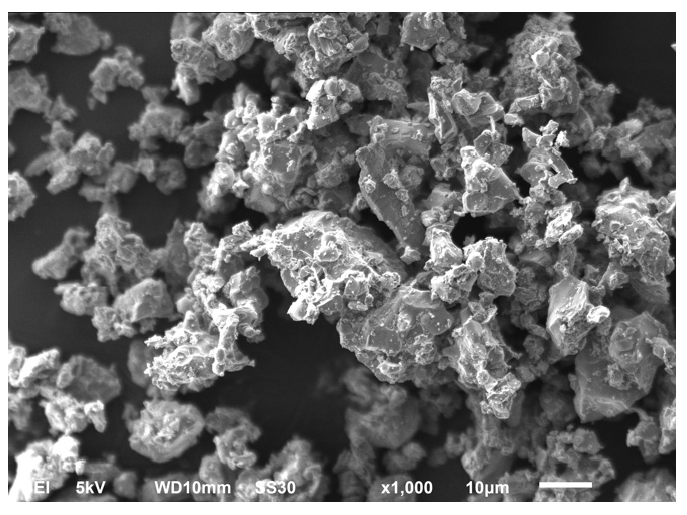
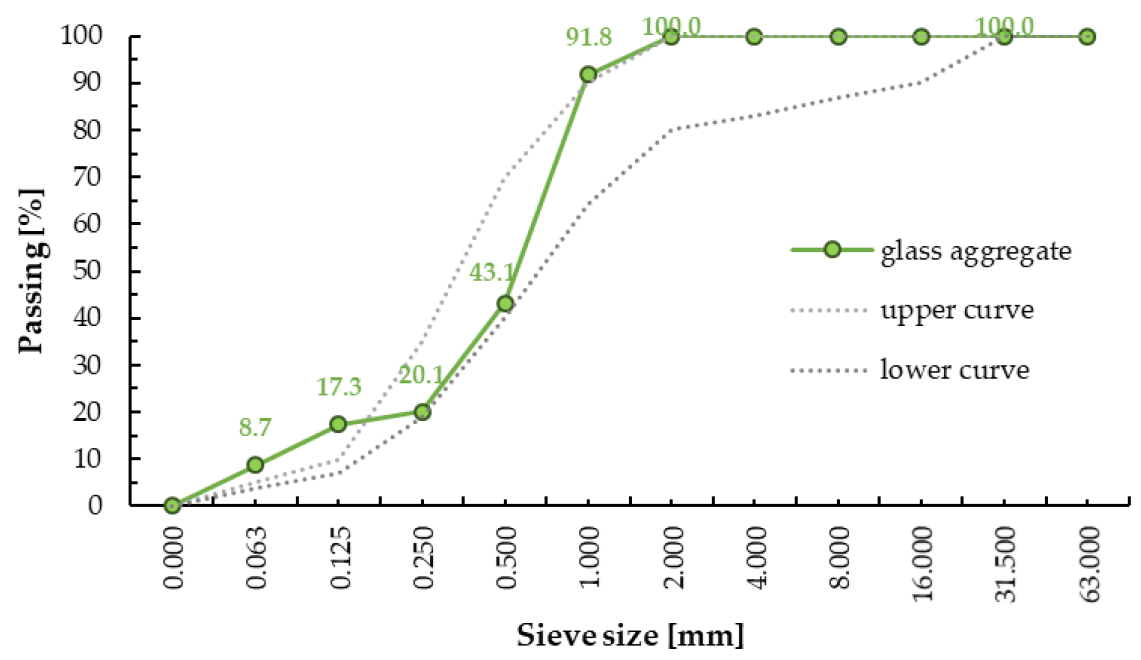

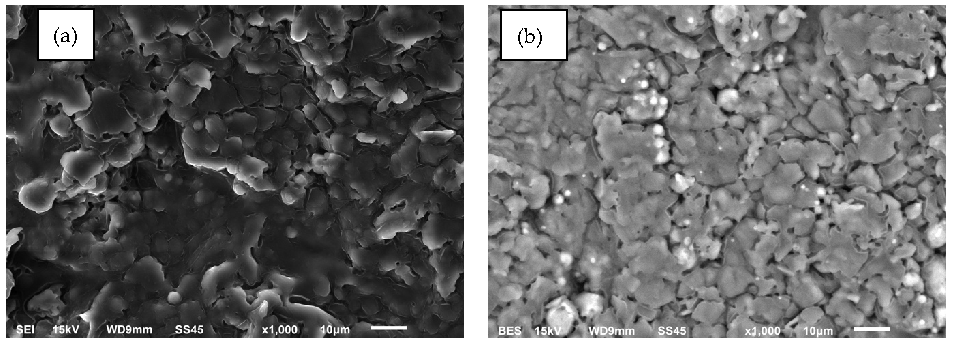
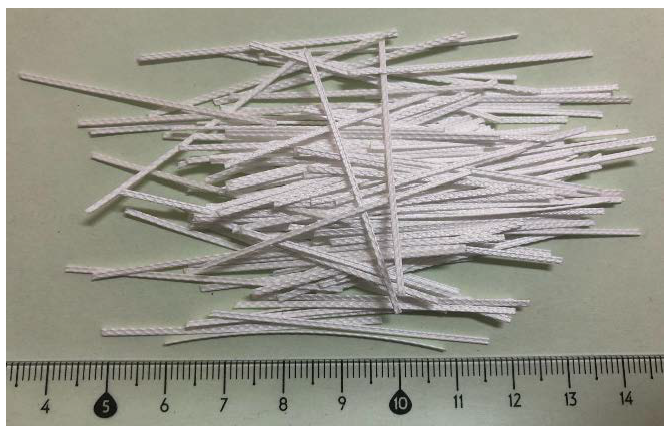
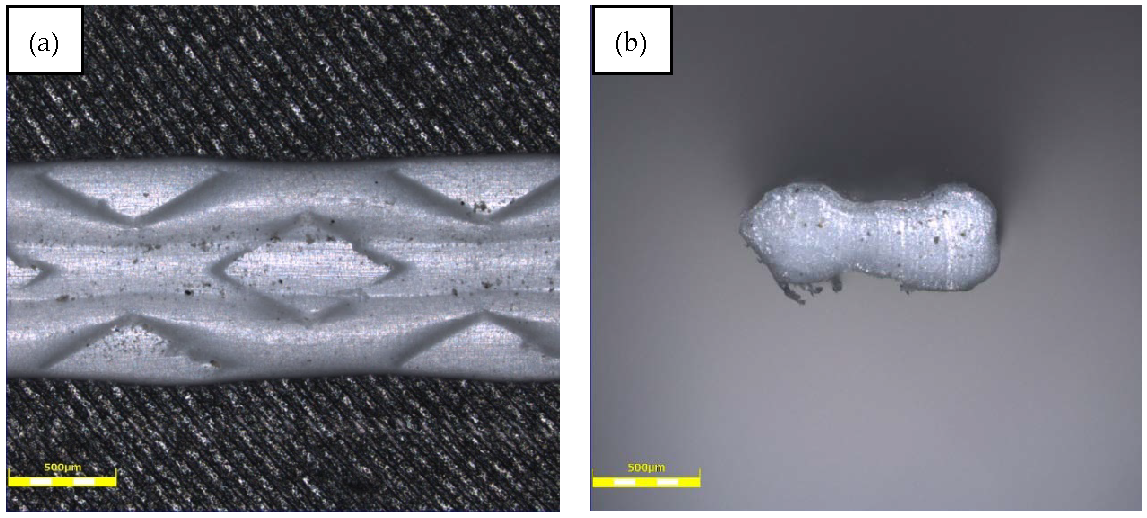

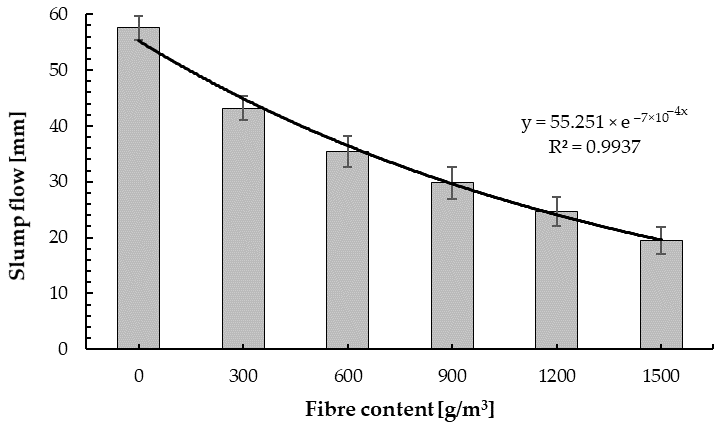
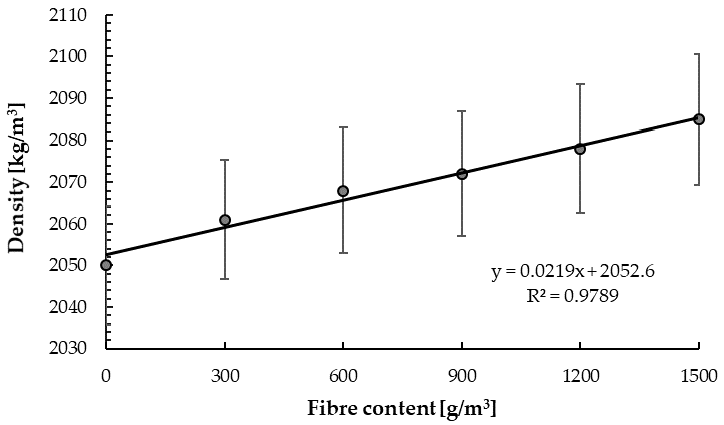
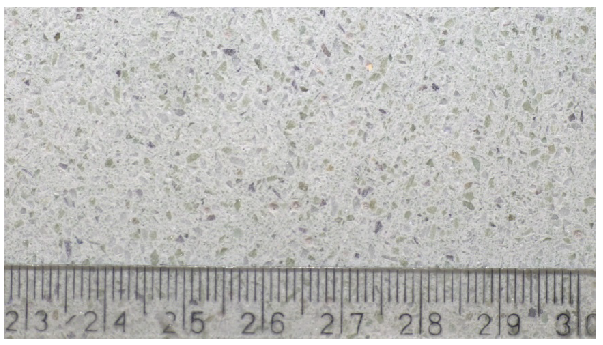
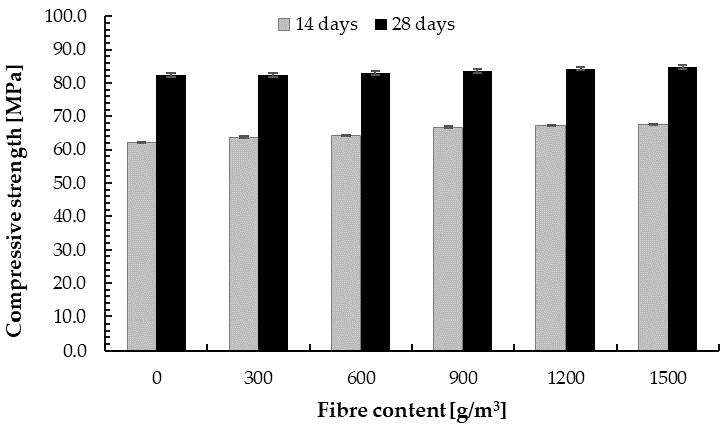
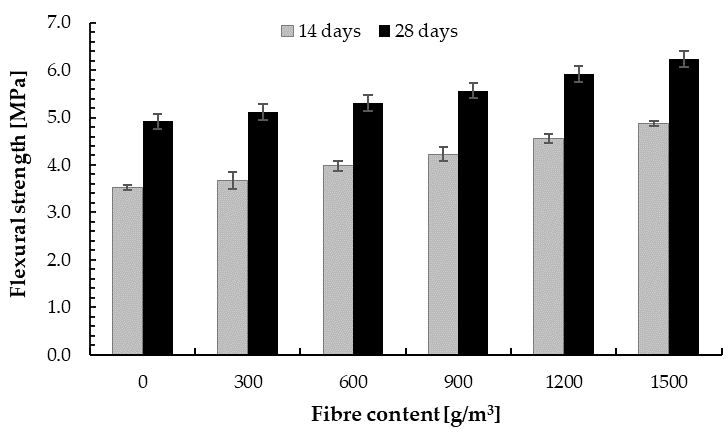
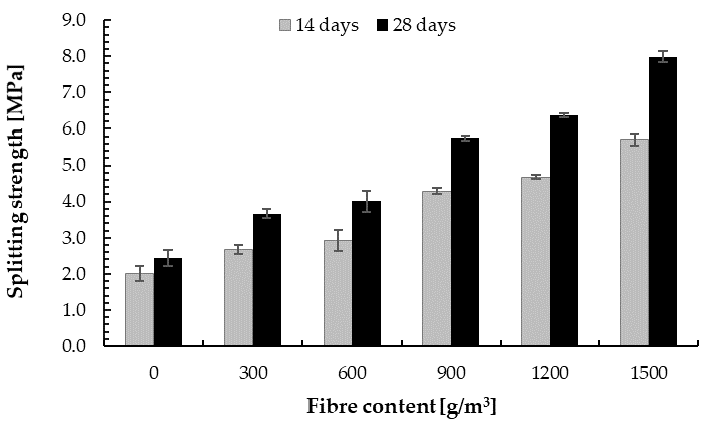
| Compositions | SiO2 | Al2O3 | Fe2O3 | CaO | MgO | SO3 | Na2O | K2O | TiO2 | Cl | |
|---|---|---|---|---|---|---|---|---|---|---|---|
| Unit (vol.%) | Cement | 19.5 | 4.9 | 2.9 | 63.3 | 1.3 | 2.8 | 0.1 | 0.9 | - | 0.05 |
| Glass | 70.0–74.0 | 0.5–2.0 | 0.0–0.1 | 7.0–11.0 | 3.0–5.0 | - | 13.0–15.0 | 0.0–0.1 | - | ||
| Properties | Specific Surface Area [m2/kg] | Specific Gravity [kg/m3] | Compressive Strength after Days [MPa] | ||
|---|---|---|---|---|---|
| Materials | 2 Days | 7 Days | 28 Days | ||
| Cement | 400 | 3090–3190 | 40–48 | 53–65 | 66–76 |
| Glass | 100 | 2450 | - | - | - |
| Mix Symbol | Cement [kg] | Water [kg] | Glass Powder [kg] | Glass Sand Aggregate | Fibre [g] | |
|---|---|---|---|---|---|---|
| 0.1–0.9 mm | 0.9–2.0 mm | |||||
| M0 | 480 | 140 | 600 | 510 | 790 | 0.0 |
| M1 | 300 | |||||
| M2 | 600 | |||||
| M3 | 900 | |||||
| M4 | 1200 | |||||
| M5 | 1500 | |||||
| Mix Symbol | Fibre Content [g/m3] | Slump Cone [mm] | Air Content [%] |
|---|---|---|---|
| M0 | 0 | 58 ± 2 | 4.0 ± 0.5 |
| M1 | 300 | 43 ± 2 | 3.8 ± 0.3 |
| M2 | 600 | 35 ± 3 | 3.9 ± 0.2 |
| M3 | 900 | 30 ± 3 | 3.5 ± 0.5 |
| M4 | 1200 | 25 ± 3 | 3.6 ± 0.6 |
| M5 | 1500 | 20 ± 3 | 3.6 ± 0.6 |
| Mix Symbol | Density [kg/m3] | Compressive Strength [MPa] | Flexural Strength [MPa] | Splitting Strength [MPa] | Elastic Modulus [GPa] | Poisson Ratio [[–] | |||
|---|---|---|---|---|---|---|---|---|---|
| 14 Day | 28 Day | 14 Day | 28 Day | 14 Day | 28 Day | ||||
| M0 | 2050 ± 14 | 62.1 ± 0.8 | 82.5 ± 0.8 | 3.5 ± 0.1 | 4.9 ± 0.2 | 2.0 ± 0.7 | 2.5 ± 0.8 | 31 ± 1 | 0.15 ± 0.01 |
| M1 | 2061 ± 14 | 63.8 ± 0.9 | 82.6 ± 0.5 | 3.7 ± 0.6 | 5.1 ± 0.1 | 2.7 ± 0.4 | 3.7 ± 0.4 | 32 ± 1 | 0.15 ± 0.02 |
| M2 | 2068 ± 15 | 64.2 ± 0.3 | 83.0 ± 0.8 | 4.0 ± 0.3 | 5.3 ± 0.1 | 2.9 ± 0.9 | 4.0 ± 0.8 | 32 ± 1 | 0.15 ± 0.02 |
| M3 | 2072 ± 15 | 66.8 ± 0.8 | 83.8 ± 0.3 | 4.2 ± 0.5 | 5.6 ± 0.1 | 4.3 ± 0.2 | 5.8 ± 0.3 | 32 ± 1 | 0.15 ± 0.01 |
| M4 | 2078 ± 15 | 67.3 ± 0.3 | 84.4 ± 0.6 | 4.6 ± 0.3 | 5.9 ± 0.1 | 4.7 ± 0.1 | 6.4 ± 0.6 | 32 ± 2 | 0.15 ± 0.02 |
| M5 | 2085 ± 16 | 67.6 ± 0.6 | 84.8 ± 0.6 | 4.9 ± 0.1 | 6.2 ± 0.2 | 5.7 ± 0.5 | 8.0 ± 0.6 | 32 ± 1 | 0.15 ± 0.01 |
Publisher’s Note: MDPI stays neutral with regard to jurisdictional claims in published maps and institutional affiliations. |
© 2021 by the authors. Licensee MDPI, Basel, Switzerland. This article is an open access article distributed under the terms and conditions of the Creative Commons Attribution (CC BY) license (http://creativecommons.org/licenses/by/4.0/).
Share and Cite
Małek, M.; Łasica, W.; Kadela, M.; Kluczyński, J.; Dudek, D. Physical and Mechanical Properties of Polypropylene Fibre-Reinforced Cement–Glass Composite. Materials 2021, 14, 637. https://doi.org/10.3390/ma14030637
Małek M, Łasica W, Kadela M, Kluczyński J, Dudek D. Physical and Mechanical Properties of Polypropylene Fibre-Reinforced Cement–Glass Composite. Materials. 2021; 14(3):637. https://doi.org/10.3390/ma14030637
Chicago/Turabian StyleMałek, Marcin, Waldemar Łasica, Marta Kadela, Janusz Kluczyński, and Daniel Dudek. 2021. "Physical and Mechanical Properties of Polypropylene Fibre-Reinforced Cement–Glass Composite" Materials 14, no. 3: 637. https://doi.org/10.3390/ma14030637
APA StyleMałek, M., Łasica, W., Kadela, M., Kluczyński, J., & Dudek, D. (2021). Physical and Mechanical Properties of Polypropylene Fibre-Reinforced Cement–Glass Composite. Materials, 14(3), 637. https://doi.org/10.3390/ma14030637









